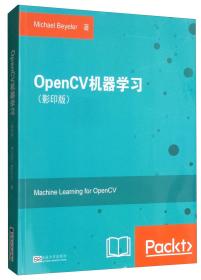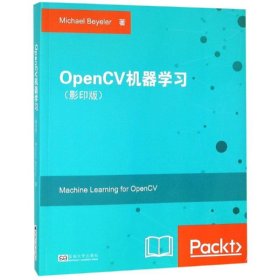
OPENCV机器学习(影印版)
全新正版 极速发货
¥ 46.75 4.9折 ¥ 96 全新
库存2件
广东广州
认证卖家担保交易快速发货售后保障
作者MichaelBeyeler
出版社东南大学出版社
ISBN9787564183240
出版时间2019-04
装帧平装
开本其他
定价96元
货号1201882983
上书时间2024-06-06
- 最新上架
商品详情
- 品相描述:全新
- 商品描述
-
作者简介
迈克尔?贝耶勒是华盛顿大学神经工程和数据科学专业的博士后,主攻仿生视觉计算模型,用以为盲人植入人工视网膜(仿生眼睛),改善盲人的视觉体验。他的工作属于神经科学、计算机工程、计算机视觉和机器学习的交叉领域。他也是2015年Packt出版的《OpenCV with Python Blueprints》一书的作者,该书是构建不错计算机视觉项目的实用指南。同时他也是多个开源项目的积极贡献者,具有Python、C/C++、CUDA、MATLAB和Android的专业编程经验。他还拥有加利福尼亚大学欧文分校计算机科学专业的博士学位、瑞士苏黎世联邦理工学院生物医学专业的硕士学位和电子工程专业的学士学位。当他不“呆头呆脑”地研究大脑时,他会攀登雪山、参加现场音乐会或者弹钢琴。
目录
Preface
Chapter 1:A Taste of Machine Learning
Getting started with machine learning
Problems that machine learning can solve
Getting started with Python
Getting started with OpenCV
Installation
Getting the latest code for this book
Getting to grips with Pythons Anaconda distribution
Installing OpenCV in a conda environment
Verifying the installation
Getting a glimpse of OpenCVs ML module
Summary
Chapter 2: Working with Data in OpenCV and Python
Understanding the machine learning workflow
Dealing with data using OpenCV and Python
Starting a new IPython or Jupyter session
Dealing with data using Pythons NumPy package
Importing NumPy
Understanding NumPy arrays
Accessing single array elements by indexing
Creating multidimensional arrays
Loading external datasets in Python
Visualizing the data using Matplotlib
Importing Matplotlib
Producing a simple plot
Visualizing data from an external dataset
Dealing with data using OpenCVs TrainData container in C++
Summary
Chapter 3: First Steps in Supervised Learning
Understanding supervised learning
Having a look at supervised learning in OpenCV
Measuring model performance with scoring functions
Scoring classifiers using accuracy, precision, and recall
Scoring regressors using mean squared error, explained variance, and R squared
Using classification models to predict class labels
Understanding the k-NN algorithm
Implementing k-NN in OpenCV
Generating the training data
Training the classifier
Predicting the label of a new data point
Using regression models to predict continuous outcomes
Understanding linear regression
Using linear regression to predict Boston housing prices
Loading the dataset
Training the model
Testing the model
Applying Lasso and ridge regression
Classifying iris species using logistic regression
Understanding logistic regression
Loading the training data
Making it a binary classification problem
Inspecting the data
Splitting the data into training and test sets
Training the classifier
Testing the classifier
Summary
Chapter 4: Representing Data and Engineering Features
Understanding feature engineering
Preprocessing data
Standardizing features
Normalizing features
Scaling features to a range
Binarizing features
Handling the missing data
Understanding dimensionality reduction
Implementing Principal Component Analysis (PCA) in OpenCV
Implementing Independent Component Analysis (ICA)
Implementing Non-negative Matrix Factorization (NMF)
Representing categorical variables
Representing text features
Representing images
Using color spaces
Encoding images in RGB space
Encoding images in HSV and HLS space
Detecting corners in images
Chapter 5: Using Decision Trees to Make a Medical Diagnosis
Chapter 6: Detecting Pedestrians with Support Vector Machines
Chapter 7: Implementing a Spam Filter with Bayesian Learning
Chapter 8: Discovering Hidden Structures with Unsupervised Learning
Chapter 9: Using Deed Learning to Classifv Handwritten Diqits
Chapter 10: Combining Different Algorithms into an Ensemble
Chapter 11:Selecting the Right Model with Hyperparameter Tuning
Chapter 12: Wrapping Up
内容摘要
本书首先介绍了统计学习的基本概念,例如分类和回归。介绍完所有的基础知识之后,就开始探究如决策树、支持向量机、贝叶斯网络等算法,学习如何将它们与其他OpenCV功能综合运用。你的机器学习技能会随着书中内容的进度一同提高,直到准备好学习当前很热门的主题:深度学习。在本书的结尾,你可以根据现有的源代码构建或是从头开发自己的算法来解决自己碰到的机器学习问题!
相关推荐
— 没有更多了 —



















以下为对购买帮助不大的评价